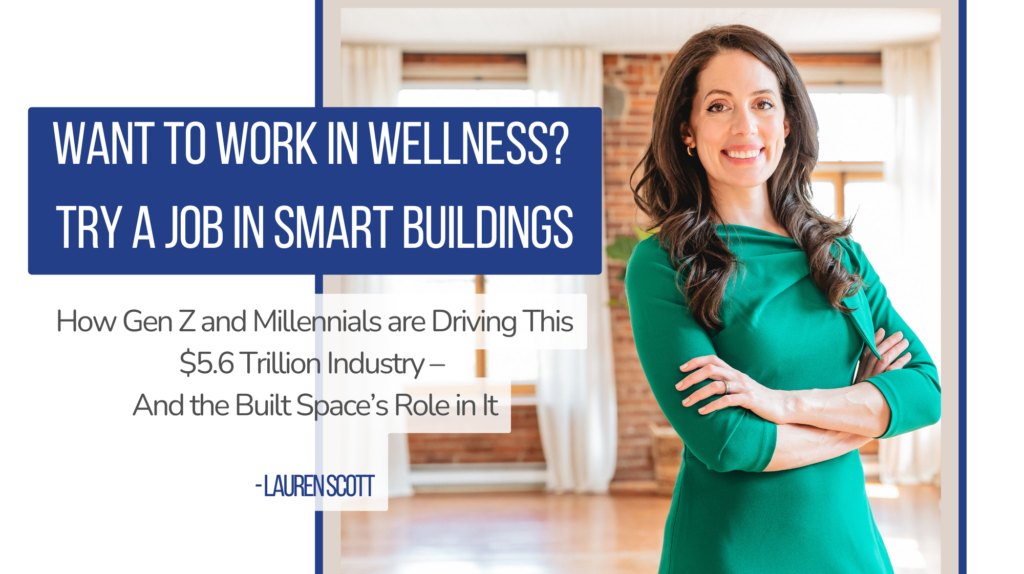How Gen Z and Millennials are Driving This $5.6 Trillion Industry – And the Built Space’s Role in It
By Lauren Scott
The following is an adaptation of an episode of The Resilience Report podcast, hosted by Lauren Scott
If you are an AutomatedBuildings.com reader who falls into one of the following camps, this article if for you: those who are just starting their career and those who are looking to maybe make a mid-career pivot into a values-based organization. More specifically, we will be diving into how, if you are someone who wants a career in the booming wellness industry, maybe you should think about finding a job in the sustainability sector.
This might not seem like the most direct link. However, I really had a revelation over the past couple of weeks when speaking to a former colleague. We were having a conversation about where we ultimately see the rest of our careers playing out. This contact of mine said to me, well, obviously you’ll always be in the environmental space. While not wrong, I did respond back to her “well, sure, but probably over the next 30 years, it will either be the environmental space or maybe the wellness sector”.
Those who know me know that I am extremely passionate about our environmental impact. What might be more surprising, however, is that I am also someone who is a big advocate of people taking care of ourselves so that we can take care of others: I love exercise, I love nutrition, I love supplementation, I love the wellness space overall. And so, I thought, “well, maybe one or maybe the other”. After the conversation, however, I got to thinking: maybe I’ve always been working in a combination of the two by working in cleantech! And as I began diving into the topic deeper, I realized that so many jobs within the sustainability space are actually, at the root of it, also wellness careers.
To start, let’s look at how big the wellness sector really is, because personally I had no idea! Anecdotally I had a feeling – I mean, this seems to be everywhere in terms of Instagram/TikTok and podcasts. But to give concrete figures: in 2022, the wellness industry overall was sitting at $5.6 trillion, which is already crazy. But, by 2027 (so we’re just talking five years later) this number is expected to explode to $8.5 trillion. To give you a little bit of context, that is 2 times the GDP of Germany!
So, who’s driving all of this demand? If you guessed Gen Z and millennials, you’re absolutely right. Certainly, from a consumer standpoint, we know that industries ranging from that of beauty or health (for example the GOOPs of the world), fitness, nutrition plans, spas: a lot of the consumer pressure is coming from Millennial and Gen Z consumers. And yes, they’re creating demand for those products, but they’re also asking and pushing for wellness from their employers, which brings us back to this career path.
No surprise as we all lived through it, but in 2020, one of the beautiful things that came out of it was the pressure from Gen Z and millennials on employers to more greatly consider the overall wellness of their employees. This was perhaps mostly physical considerations of making sure everything was set up ergonomically to begin, but there was also this huge emphasis on mental wellbeing. Fast-forward 4 years later, and this is now part of our day-to-day conversations with companies really investing in making sure that their employees have an outlet and the right kind of resources to take care of their mental health.
Gen Z and millennials are also a driving force behind another trend, tied again with employers, which is environmental impact. A recent McKenzie report again found that more than 40% of millennials and Gen Zs would consider leaving or have already left a job because the company was not living up to their ESG expectations. Even more staggering is that, when these two groups are even just considering careers, 75% are looking at the environmental impact of these organizations. Therefore, you have these two groups who are absolutely pushing for both wellness and environmental responsibility.
You might be asking yourself, “well, I’m not in either of these groups. Why should I really care about this topic?” Well, the reality is that, by next year, these two groups are actually going to make up 30% of the global workforce. So, whether you are part of these groups or not, it is definitely going to shape many of our relationships as employers and as colleagues.
Now that we have covered the size of the industry as well as the two generations influencing both wellness and the environmental space, an interesting overlap emerges. During the pandemic, there was a lot of talk about mental health / anxiety and what we can do to empower people in the workforce. And study after study after study has shown that, the moment we feel we have some sort of agency or impact in the face of a stressful situation, it already has a positive impact on our mental health. Which is why I think it is so important for people who care about these two topics to work in the sustainability space.
From myself, I admittedly have deep moments of anxiety when I see the extreme weather patterns sweeping across the world. Whether the wildfires and subsequent orange skies that we had in the summer of 2023 in Canada (and that are now witnessing again in 2024 with the devastation in Jasper) or the different storms impacting loved ones, the news can really take its toll. But the thing that gets me through it, and I think the thing that can help a lot of people get through these situations, is knowing that, when you dedicate your career to sustainability, you do have an impact and you do have agency. And so, when I’m feeling stressed, I at least get to realize that every day I get to wake up and have a positive impact on the environmental space and that really does turn it around for me. I can think “I’m dedicating all of my love and energy and passion within my professional hours to this cause” and it really shifts things for me and further emphasizes the intersection of wellness and sustainability.
Finally, to kind of take it all home, the real “aha moment” for me was when I was having this conversation and doing my research. I’ve been working full-time for more than 16 years and 11 of those have been working in the sustainability space (primarily in renewable energy and smart buildings). For renewable energy, the link between wellness and sustainability is quite clear in the sense that if you’re using clean energy, you have less emissions: less emissions equals a healthier environment. So that’s a pretty direct connection.
The smart building sector is probably an area where the correlation is less obvious – and I should emphasize unless you’re in the building industry and then maybe you’re saying “duh, Lauren, we’ve been talking about this for decades”. To be fully transparent, it was a little bit of a wakeup call that yes, we’re focused on making buildings more energy efficient, however, we are also focused on making the built experience as healthy as possible. And why is this important? Because so much of the wellness industry is just a little moment in time. So, it might be a one-hour workout; it might be a quick supplement; it might be a red-light treatment for 20 minutes. However, we spend 90% of our time indoors, so the quality of that experience has a huge impact on our wellness. 2020 certainly showed us and highlighted the impact of indoor air quality and emphasized how technology can be used to take care of IAQ and take care of those within the build space whether students or patients or seniors or you and me. But there might also be other areas that you haven’t thought about, for example lighting and its impact on our circadian rhythm, building and finishing materials, humidity levels and so much more! So, whether it’s the BMS or lighting or beyond, there’s certainly so many different opportunities for you to take wellness into consideration when pursuing a career in sustainability.
I sincerely hope that if we have even just one reader who is thinking about joining the wellness industry like me, that you consider pursuing a career that overlaps into sustainability. Smart buildings, specifically, might be the wellness space you have been looking for!



